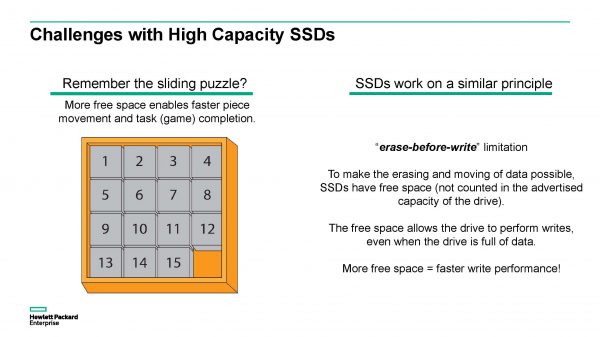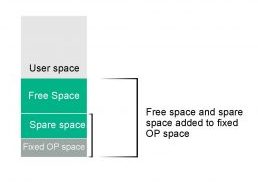HPE announced massive new SSD drive offerings for its 3PAR StoreServ arrays — a 7.68TB and 15.36TB drive in size. The new drives double and quadruple the former 3.84TB high-end drive. And with these new drive offerings, HPE has leapfrogged the spinning disk capacities with this new generation of SSD drives with incomparable performance.
Sizing
The first thing you may notice is the odd sizing on these drives, but those sizes are the product of taking industry standard SSD drives and applying the 3PAR method of sparing to them. The previous large capacity SSD for a 3PAR StoreServ was 3.84TB in size, also an odd size. Truth be told, these are the same enterprise drives that the SSD vendors sell as a 3.2TB drive. The 3PAR arrays don’t actually use a special type of SSD drive – these are the same standard SSD drives available to other vendors. So how do you get this odd increase in size?
With the 3PAR StoreServ architecture, it has always allocated spare space at the array level, reserving space for failures. This goes back to the origins of the 3PAR’s design on spinning disks. Because 3PAR has a sparing technique called Adaptive Sparing at the array level, HPE went to the SSD vendors and asked them to allow HPE the reserved space on the SSD normally used as spare blocks. By combining Adaptive Sparing across a much larger set of disks, HPE is able to unlock access to to more of the capacity you’re already paying for and let you get real use out of that. HPE is able to do this without introducing new risk because it is already handling sparing at the array level. Where HPE could have been at a disadvantage due to it’s sparing technique [taking away space from a 3.2TB, 6.4TB or 12.8TB disk], this becomes a benefit to the customer. HPE also stands behind its SSD technology with a 5 year, unconditional warranty on its SSD drives.
Now, this year, another thing has happened. Since HPE went to the drive vendors and asked to tap into the spare space, the drive vendors themselves are sizing the enterprise SSD’s at the newly unleashed larger sizes and other storage vendors are following the HPE lead in handling sparing at the array level. So, in this case, you’ll see Samsung advertising the 7.68TB and 15.36TB drive sizes – instead of 6.4TB and 12.8TB drives with full fixed overprovisioning space. I talked to a Samsung marketing manager while at HPE Discover and he confirmed these sizes. (That’s a whole lot of spare space as we keep sizing up, isn’t it!?)
The Real Story Isn’t the Sizes
Folks I talked to at HPE Discover in Las Vegas last week insist that the real story isn’t the increased drive sizes. The real story is around a new technique in Adaptive Sparing – something HPE is calling Adaptive Sparing 2.0. To really understand the benefits of the new technique, its important to know that SSD’s work on a ‘erase before write’ principal, explained in the graphic below. Adaptive Sparing 2.0 opens up more free space to accelerate writes on each drive.


Adaptive Sparing 2.0
The Adaptive Sparing 2.0 technique combines free space, spare space and the fixed overprovisioning space on the SSD together to further increase the effective overprovisioning space of the array. Fixed overprovisioning space is the fancy term for that spare space the SSD vendors reserve on SSD drives.
3PAR StoreServ arrays also combine other features like system-wide striping and express layout to allow for greater performance and endurance of the drives. These features allow for even use across your SSD drives which prolongs the life of the drive wearing the same few drives out prematurely. These same features that boosted performance by spreading data across a larger number of spindles on spinning disk is also benefiting you in the SSD world today.
The full active/active nature of the 3PAR architecture also allows increased performance – with active/active host connections for optimal performance host to array, mesh-active controllers where all controllers can access all the drives in the array for even wear and balance of data, and for SSD drives, each drive is dual-ported, allowing active/active SSD access from each node in the node pair. Dual-ported SSD drives doubles the available bandwidth to and from each SSD – allowing for full duplex speeds for every IO transaction.
Whether by incredible luck or very strategic planning or most likely a little of both – the truth is customers are still benefiting from the architecture choices made well over a decade ago when the 3PAR arrays were first being designed.
HPE has a slide deck with more details that I’ve embedded below:
